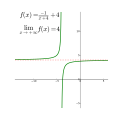Limit of a function
In calculus, a branch of mathematics, the limit of a function is the behavior of a certain function near a selected input value for that function. Limits are one of the main calculus topics, along with derivatives, integration, and differential equations.
Definition of the limit
The definition of the limit is as follows:
- If the function [math]\displaystyle{ f(x) }[/math] approaches a number [math]\displaystyle{ L }[/math] as [math]\displaystyle{ x }[/math] approaches a number [math]\displaystyle{ c }[/math], then [math]\displaystyle{ \lim_{x \to c}f(x) = L. }[/math]
The notation for the limit above is read as "The limit of [math]\displaystyle{ f(x) }[/math] as [math]\displaystyle{ x }[/math] approaches [math]\displaystyle{ c }[/math] is [math]\displaystyle{ L }[/math]", or alternatively, [math]\displaystyle{ f(x) \to L }[/math] as [math]\displaystyle{ x \to c }[/math] (reads "[math]\displaystyle{ f(x) }[/math] tends to [math]\displaystyle{ L }[/math] as [math]\displaystyle{ x }[/math] tends to [math]\displaystyle{ c }[/math]"[1]). Informally, this means that we can make [math]\displaystyle{ f(x) }[/math] as close to [math]\displaystyle{ L }[/math] as possible—by making [math]\displaystyle{ x }[/math] sufficiently close to [math]\displaystyle{ c }[/math] from both sides (without making [math]\displaystyle{ x }[/math] equal to [math]\displaystyle{ c }[/math]).[2]
Imagine we have a function such as [math]\displaystyle{ f(x)={1 \over x^2} }[/math]. When [math]\displaystyle{ x=0 }[/math], [math]\displaystyle{ f(x) }[/math] is undefined, because [math]\displaystyle{ f(0)={1 \over 0 ^ {2}} }[/math] and division by zero is undefined. On the Cartesian coordinate system, the function [math]\displaystyle{ f(x) = {1 \over x ^ 2} }[/math] would have a vertical asymptote at [math]\displaystyle{ x=0 }[/math]. In limit notation, this would be written as:
- The limit of [math]\displaystyle{ 1 \over x^2 }[/math] as [math]\displaystyle{ x }[/math] approaches [math]\displaystyle{ 0 }[/math] is [math]\displaystyle{ \infty }[/math], which is denoted by [math]\displaystyle{ \lim_{x \to 0}{1 \over x^2} = \infty. }[/math]
Right and left limits
Consider the function [math]\displaystyle{ f(x)={1 \over x} }[/math], we can get as close to [math]\displaystyle{ 0 }[/math] in the [math]\displaystyle{ x }[/math]-values as we want, so long as we do not make [math]\displaystyle{ x }[/math] equal to [math]\displaystyle{ 0 }[/math]. For instance, we could make x=.00000001 or -.00000001, but never 0. Therefore, we can get [math]\displaystyle{ f(x) }[/math] as close as we want to [math]\displaystyle{ \infty }[/math] or [math]\displaystyle{ - \infty }[/math] depending on if we approach 0 from the right side or the left side.[3] The left limit is the limit the function tends to if we only approach the target x-value from the left, for instance in the case of [math]\displaystyle{ f(x)={1 \over x} }[/math] when getting close to the 0 x-value from the left side, by using x-values that are smaller than 0, the limit would approach [math]\displaystyle{ - \infty }[/math]. In the same way, the right limit is the limit the function tends to if we only approach the target x-value from the right, for instance in the case of [math]\displaystyle{ f(x)={1 \over x} }[/math] when getting close to the 0 x-value from the right side, by using x-values that are larger than 0, the limit would approach [math]\displaystyle{ \infty }[/math].
Limit Of A Function Media
Function without a limit at an essential discontinuity
Related pages
- Derivative (mathematics), a quantity defined as a limit of slopes
- Infinity
- Limit of a sequence
References
- ↑ "List of Calculus and Analysis Symbols". Math Vault. 2020-05-11. Retrieved 2020-09-14.
- ↑ "Calculus I - The Limit". tutorial.math.lamar.edu. Retrieved 2020-09-14.
- ↑ "2.2: Limit of a Function and Limit Laws". Mathematics LibreTexts. 2018-04-11. Retrieved 2020-09-14.





